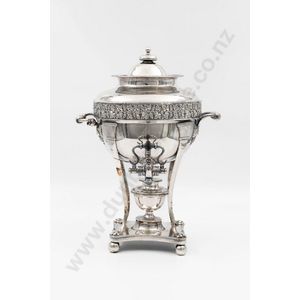19th Century Sheffield Plate Neo-Classical Tea Urn with Grape Design
19th century Sheffield plate samovar or tea urn, of neo-classical design, two handled oval shape with a band of grapes and vines on four scroll supports with lions paw feet, concave base on ball feet, 39 cm height (some faults)
You must be a subscriber, and be logged in to view price and dealer details.
Subscribe Now to view actual auction price for this item
When you subscribe, you have the option of setting the currency in which to display prices to $Au, $US, $NZ or Stg.
This item has been sold, and the description, image and price are for reference purposes only.
- Lion's Paw - The decorative lion's paw has been used in furniture, silver, and ceramics for centuries. It is a stylized representation of the paw of a lion, often depicted in a highly realistic or stylized form.
In furniture design, lion's paws were popular in the neoclassical and Empire styles of the late 18th and early 19th centuries. They were often used as feet on tables, chairs, and other pieces of furniture. The lion's paw was a popular motif for furniture makers because it added a sense of grandeur and regalness to their pieces.
In silverware design, the lion's paw was often used on the feet of tea and coffee pots, as well as on other pieces of silverware such as wine coolers and tureens. The lion's paw was often used in combination with other neoclassical motifs, such as acanthus leaves or grape clusters, to create a sense of grandeur and classical elegance.
In ceramics, lion's paws were commonly used as feet on vases, urns, and other pottery items. The lion's paw was often depicted in relief or as a highly stylized form, and was sometimes used in combination with other decorative elements, such as garlands or swags. - Sheffield Plate - Sheffield plate was the first commercially viable method of plating metal with silver. The method of plating was invented by Thomas Boulsover, a Sheffield Cutler, in 1743 and involved sandwiching an ingot of copper between two plates of silver, tightly binding it with wire, heating it in a furnace and then milling it out in to sheet, from which objects could be made.
Originally used by its inventor to make buttons, the potential of the material was quickly realised, and soon it was being used to fashion boxes, salvers and jugs, and not long after that candlesticks and coffee pots, and other traditional tableware.
Although there was a considerable saving in the amount of silver used, Old Sheffield Plate manufacture was more labour intensive than solid silver, meaning higher labour costs. This meant that Old Sheffield Plate was very much a luxury product, and only available to the very wealthy.
The thickness of the silver means that many 18th century Sheffield Plate pieces still have a good layer of silver, while electroplated pieces (EPNS), may have been replated several times over their lifetime. Where the silver has worn off the Sheffield plate the soft glow of the copper base can be seen underneath. However this is not an infallible guide that the piece is Sheffield Plate, as many EPNS items were also plated on to a copper base.
Most Sheffield plate items are unmarked, whereas most elecroplated items display manufacturers names or marks, quality indications such as "A1", "EP", together with pattern or model numbers.
Sheffield plate was made commercially between 1750 and 1850. - Neo Classical - The period or style, known as "neo-classical", was based on Greek and Roman designs and motifs, and is usually associated with the influence of the four Adam brothers, but principally Robert Adam, the second oldest of the brothers, who were architects and designers, active in the latter half ot the 18th century (1760s to 1790s).
Born in Scotland in 1728, Robert Adam spent time in Italy studying and his designs are influenced by the finds made during the excavation of Pompei.
When he returned to England he became the Court Architect to George III (1738-1820).
In turn, designs by Adam then influenced Hepplewhite.
Neo-classical ornamentation is characterised by use of classical urns, palmettes, mythical creatures such as the sphinx and griffin, ram's heads, swags, scrolling foliage, and use of the Greek key pattern.
This item has been included into following indexes:
